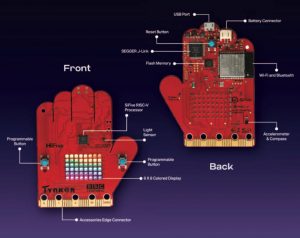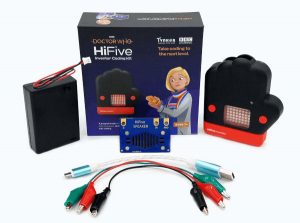The BBC has put its name behind yet another children’s IoT coding platform, this time it is ‘HiFive Inventor’. which follows on from the BBC Micro decades ago and more recently BBC micro:bit.
Linking it to the TV series Dr Who, accompanying material will feature the voice the thirteenth Doctor, Jodie Whittaker.
‘HiFive’ in the name give a clue to the on-board processor, which has a processor from SiFive, built around a Risc-V core. SiFive (details below) and US educational coding firm Tynker are behind the technology.
“Over the last eight years, Tynker has engaged 60 million kids worldwide in coding and we look to continue to build the next generation of innovators and problem solvers with this partnership,” said Tynker CEO Krishna Vedati. “The BBC Doctor Who HiFive Inventor is designed to spark kids’ curiosity in physical computing as they learn to program the Internet of Things using block-coding and MicroPython.”
 The hardware (details below) comes in a hand-shaped enclosure with a matrix of LEDs on the front and has built-in Wi-Fi and Bluetooth.
The hardware (details below) comes in a hand-shaped enclosure with a matrix of LEDs on the front and has built-in Wi-Fi and Bluetooth.
“Students will be able to read data from the on-board suite of sensors and program on-device decisions to display results using the fun and colourful LED-matrix display,” according to SiFive. “The HiFive Inventor is powered by a SiFive processor and comes with an illuminated USB cable, battery pack, and edge connectors to allow for expandability to a range of additional sensors and devices.”
Interfacing is though an (micro:bit – like) edge connector under the read stripe of the enclosure (see photo) .
Coding is in a visual block format for younger users or in MicroPython.
Tynker’s educational package teaches coding through self-paced stages.
Narrated by Jodie Whittaker, the learner is taken on intergalactic journeys, and through challenges like learning to code and pilot an alien spaceship, control a robot and program an exotic musical instrument, according to SiFIve.
 In the box
In the box
- HiFive Inventor mini-computer
- Doctor Who and Tynker coding lessons
- Thousands of activities and challenges
- External speaker
- Light-up USB LED cable
- External battery pack
- Crocodile clips
The processor is a SiFive FE310-G003, with a 150MHz Risc-V RV32IMAC core. It has 8kbyte one-time programmable memory, 16kbyte instruction cache, 64kbyte data SRAM – working with 512kbyte of QSPI flash on the board.
There are three independent PWM (pulse width modulation) controllers, an SPI (serial peripheral interface) controller, an I2C controller, 2x (UART) controllers and JTAG for debugging.
Alongside this is a SEGGER J-Link OB interface chip for flashing and debugging the processor, as well as handling USB comms between the board and host PC.
This enables the web browser-based deploy programming, drag-and-drop HEX programming, 2 serial ports for terminal logging and a JTAG tunnel for debugging.
Bluetooth v4.2 BR/EDR (including Bluetooth Low Energy) and Wi-Fi 802.11b/g/n (up to 150Mbit/s) are supported.
There is a reset button on the back of the board, causing a running programme to re-start – an LED will flash green when the bootloader has finished and transferred control to the program.
On the fronts are two buttons for user-interaction.
The main display is a 6 x 8 matric of RGB ‘neopixel’ LEDs.
Sensors include an accelerometer for gesture sensing. The system is set up to detect:
- Up, down, left, and right
- Face up and face down
- Freefall and shake
And it can switch the display from landscape to portrait when the device is rotated.
There is a magnetometer for compass-like use, a temperature sensor accurate to 1°C (-40 to +85°C) and an ambient light sensor.
Power is from the 3x AA cell battery pack or 3V into the edge connector – although the LED display does nt work in the latter case.
The speaker accessory in the box is 8ohm 1W with speaker a built-in amplifier.
The edge connector (under the red removable cover) has 25 terminals (3.3V max input), of which five (3V, 0V, 3x GPIO) are accessible to croc clips.
Although development appears to be a US project – BBC Doctor Who HiFive Inventor is produced by Tynker under license from BBC Studios – it will be available to order through the BBC Shop, Amazon and Sheffield-based Pimoroni amongst others.
The is an email address for educational institutions or not-for-profits interested in bulk purchases
from:

